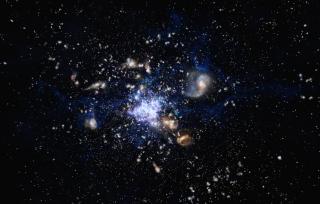Bibcode
Chen, Z.; Dannerbauer, H.; Lehnert, M. D.; Emonts, B. H. C.; Gu, Q.; Allison, J. R.; Champagne, J. B.; Hatch, N.; Indermüehle, B.; Norris, R. P.; Pérez-Martínez, J. M.; Röttgering, H. J. A.; Serra, P.; Seymour, N.; Shimakawa, R.; Thomson, A. P.; Casey, C. M.; De Breuck, C.; Drouart, G.; Kodama, T.; Koyama, Y.; Lagos, C. D. P.; Macgregor, P.; Miley, G.; Rodríguez-Espinosa, J. M.; Sánchez-Portal, M.; Ziegler, B.
Bibliographical reference
Monthly Notices of the Royal Astronomical Society
Advertised on:
1
2024
Citations
13
Refereed citations
12
Description
This paper presents the results of 475h of interferometric observations with the Australia Telescope Compact Array towards the Spiderweb protocluster at z=2.16. We search for large, extended molecular gas reservoirs among 46 previously detected CO(1-0) emitters, employing a customised method we developed. Based on the CO emission images and position-velocity diagrams, as well as the ranking of sources using a binary weighting of six different criteria, we have identified 14 robust and 7 tentative candidates that exhibit large extended molecular gas reservoirs. These extended reservoirs are defined as having sizes greater than 40 kpc or supergalactic scale. This result suggests a high frequency of extended gas reservoirs, comprising at least 30 percent of our CO-selected sample. An environmental study of the candidates is carried out based on Nth nearest neighbour and we find that the large molecular gas reservoirs tend to exist in denser regions. The spatial distribution of our candidates is mainly centred on the core region of the Spiderweb protocluster. The performance and adaptability of our method are discussed. We found 13 (potentially) extended gas reservoirs located in eight galaxy (proto)clusters from the literature. We noticed that large extended molecular gas reservoirs surrounding (normal) star-forming galaxies in protoclusters are rare. This may be attributable to the lack of observations low-J CO transitions and the lack of quantitative analyses of molecular gas morphologies. The large gas reservoirs in the Spiderweb protocluster are potential sources of the intracluster medium seen in low redshift Virgo- or Coma-like galaxy clusters.
Related projects

Molecular Gas and Dust in Galaxies Across Cosmic Time
Two of the most fundamental questions in astrophysics are the conversion of molecular gas into stars and how this physical process is a function of environments on all scales, ranging from planetary systems, stellar clusters, galaxies to galaxy clusters. The main goal of this internal project is to get insight into the formation and evolution of
Helmut
Dannerbauer